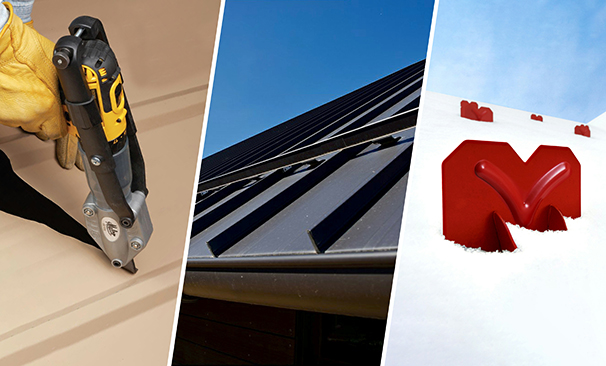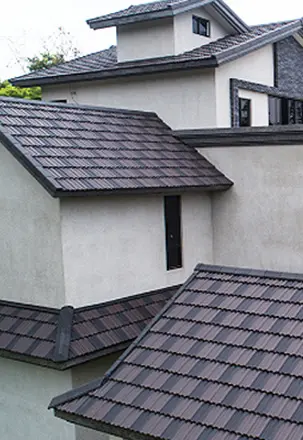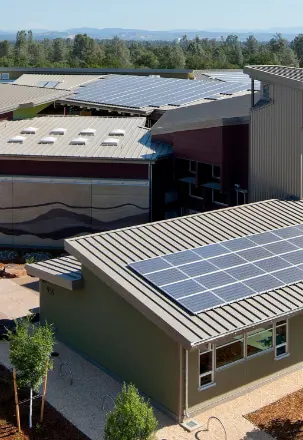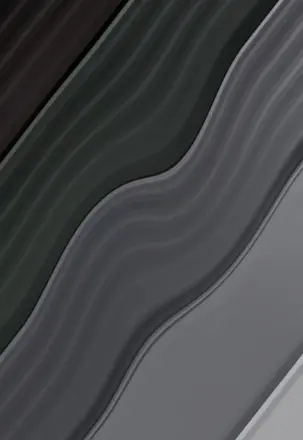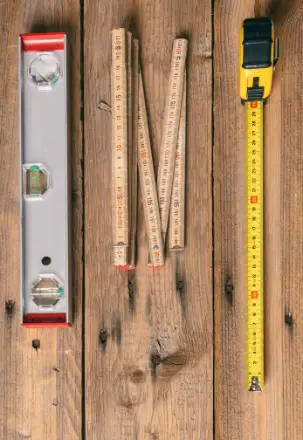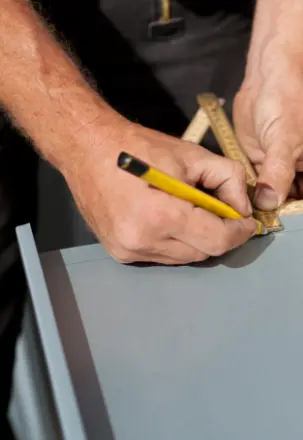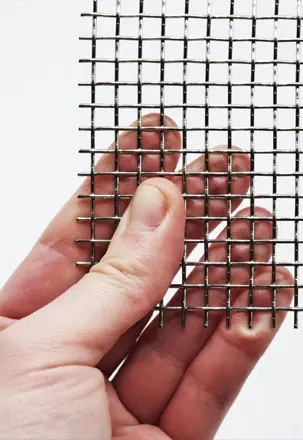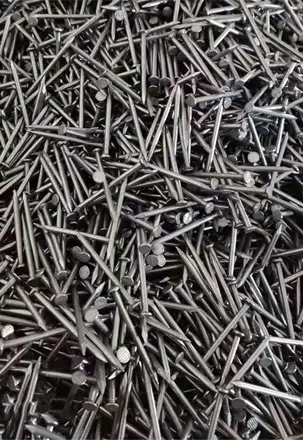When it comes to outdoor projects, construction sites, or temporary structures, tents and tarpaulins play an essential role in protection, durability, and functionality. Whether you are managing a large construction project, hosting an outdoor event, or setting up agricultural storage, selecting the right type of tent and tarpaulin can significantly affect your project’s success, cost-efficiency, and safety.
In this guide, we will explore how to choose the best tents and tarpaulins for your specific project needs. We’ll cover everything from material selection, size and thickness, weather resistance, and application scenarios to supplier evaluation and maintenance tips.
Understanding the Basics: What Are Tents and Tarpaulins?
Before diving into selection criteria, it’s important to understand what these two products are and how they differ.
1.1 Tents
A tent is a portable shelter typically made of fabric stretched over poles or a frame. It is commonly used for:
- Construction site offices or worker rest areas
- Military and disaster relief shelters
- Exhibition and event spaces
- Outdoor storage or temporary workshops
Modern industrial tents are engineered for heavy-duty use and designed to withstand harsh environments such as high winds, strong sunlight, or heavy rain.
1.2 Tarpaulins
A tarpaulin (tarp) is a large sheet of strong, flexible, and water-resistant material, often made from polyethylene (PE), PVC-coated polyester, or canvas. Tarps are used for:
- Covering equipment or materials
- Protecting vehicles and goods during transport
- Temporary roofing and construction site protection
- Agricultural applications like hay or crop covers
Tarpaulins come in various grades, coatings, and sizes depending on whether they’re meant for light, medium, or heavy-duty use.
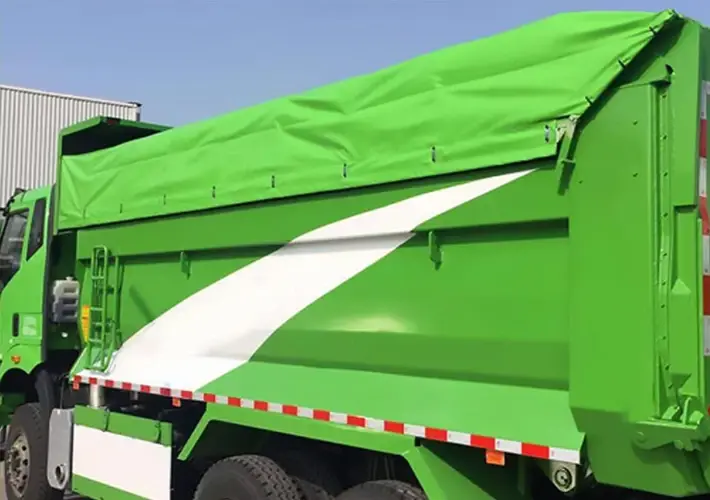
Key Factors to Consider When Choosing Tents and Tarpaulins
Selecting the best product involves balancing durability, cost, and project requirements. Below are the most important factors to evaluate.
2.1 Material Type
The material is the heart of any tent or tarpaulin. The right fabric determines strength, waterproofing, UV resistance, and lifespan.
Common Materials
- Polyethylene (PE) Tarpaulin
- Lightweight, cost-effective, and waterproof
- UV and mildew resistant
- Common for construction, agriculture, and covering goods
- Polyvinyl Chloride (PVC) Tarpaulin
- Heavier and more durable than PE
- Flame-retardant and weather-resistant
- Ideal for industrial, transportation, and event structures
- Canvas Tarpaulin
- Made from cotton or polyester blend
- Breathable, strong, and eco-friendly
- Often used for camping tents, truck covers, or outdoor storage
- Oxford Fabric
- Durable woven polyester or nylon fabric
- Common in premium tents and outdoor canopies
Pro Tip:
If your project is long-term and exposed to extreme environments, PVC-coated tarpaulin offers the best protection and lifespan. For short-term or budget projects, PE tarpaulin is more economical.
2.2 Thickness and Weight
Thickness directly affects the tarp’s strength and weather resistance.
| Grade | Thickness (mm) | GSM (g/m²) | Typical Use |
|---|---|---|---|
| Light Duty | 0.1–0.2 | 70–120 | Temporary covers, short-term use |
| Medium Duty | 0.25–0.35 | 150–200 | Construction, transport covers |
| Heavy Duty | 0.4–0.7 | 250–500 | Industrial, long-term use |
| Super Heavy Duty | 0.8+ | 550–1000+ | Military, warehouse tents |
Rule of Thumb:
For construction and industrial applications, choose at least 200 GSM or above. For outdoor events or warehousing, 500 GSM PVC tarpaulin provides superior durability.
2.3 Weather and UV Resistance
One of the most important features for outdoor applications is how well the material withstands weather exposure.
- Waterproof: PVC and PE tarps are coated to repel water effectively. Look for double-sided laminated tarpaulins for heavy rainfall conditions.
- UV Resistance: UV stabilizers prevent fabric degradation caused by sunlight.
- Temperature Resistance: Some PVC tarpaulins can endure -30°C to +70°C.
- Wind Resistance: Reinforced edges and double stitching are essential for high-wind areas.
If your project is located in regions with extreme climates—such as deserts, coastal areas, or snow-covered zones—select a UV-protected, fire-retardant PVC tarp.
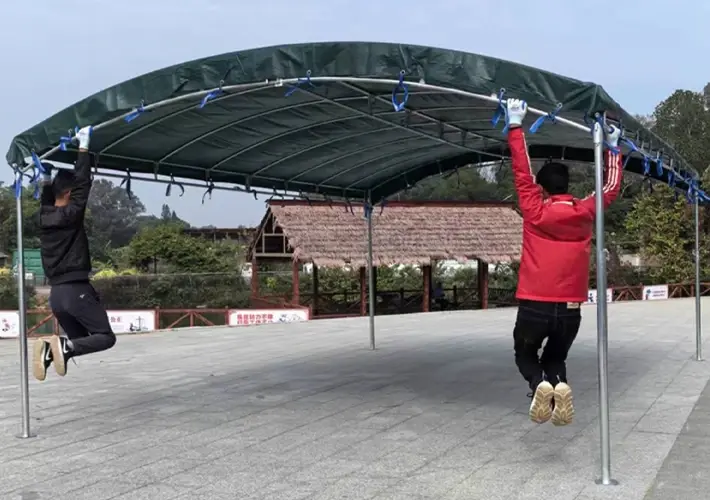
2.4 Size and Customization
Choosing the right size depends on your project scope.
Common sizes range from small (2×3 meters) for personal use to very large structures (30×60 meters) for industrial tents. For construction or logistics use, customization options include:
- Custom dimensions
- Logo printing or branding
- Reinforced eyelets, ropes, or hooks
- Zippers, doors, and ventilation openings
For B2B or project-based procurement, many Chinese factories offer OEM & ODM services, allowing full customization for large orders.
2.5 Fire Resistance and Safety Standards
If your tent or tarp will be used for public events, industrial applications, or temporary housing, it must meet fire-retardant standards such as:
- NFPA 701 (US)
- DIN 4102-B1 (Germany)
- BS 7837 (UK)
PVC tarpaulins often include fire-resistant additives, making them the best choice for safety-compliant structures.
2.6 Color and Aesthetic Options
While functionality is the priority, color also matters for branding or visibility.
| Color | Common Use |
|---|---|
| Blue/Green | General construction, waterproof covering |
| White | Event tents, warehouses (reflects sunlight) |
| Black | Privacy or UV-sensitive materials |
| Yellow/Red | High-visibility safety zones |
| Transparent | Greenhouse or light-transmission use |
For event or exhibition tents, white PVC-coated fabric gives a clean and professional appearance.
Applications of Tents and Tarpaulins in Different Industries
3.1 Construction Industry
In construction, tents and tarpaulins are indispensable for:
- Covering building materials and machinery
- Temporary on-site shelters or offices
- Protecting unfinished structures from rain and dust
- Road or bridge repair covers
PVC tarps and steel-structured tents are particularly popular due to their durability and reusability.
3.2 Agriculture
Farmers and agricultural businesses use tarpaulins for:
- Grain, hay, or fertilizer covers
- Greenhouses and shade tents
- Livestock shelters and poultry houses
- Pond liners
A UV-stabilized PE tarpaulin is a cost-effective choice for farm use, while transparent PVC films are ideal for greenhouses.
3.3 Logistics and Transportation
In logistics, tarps are used for:
- Truck and cargo covers
- Shipping container liners
- Outdoor storage protection
Heavy-duty PVC tarps are the standard for truck covers, as they provide excellent tear resistance and long service life.
3.4 Event and Exhibition
Event planners rely on custom tents for:
- Trade shows and exhibitions
- Outdoor weddings or festivals
- Sports and hospitality events
Here, aesthetic appearance and safety compliance are critical. Double-layered PVC tents with aluminum frames are preferred for large venues.
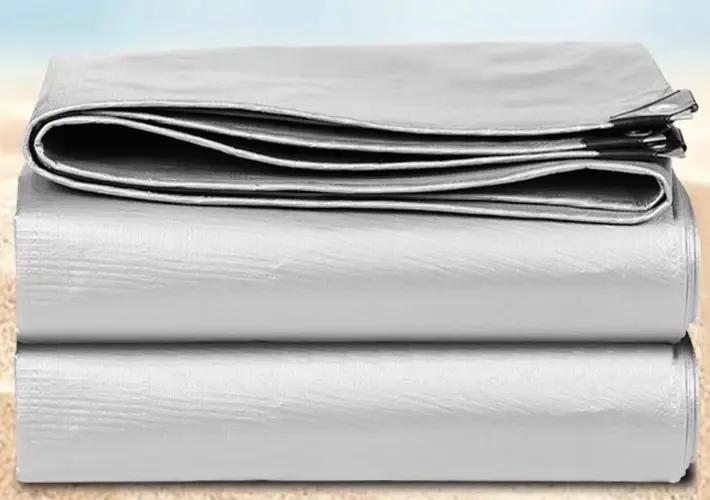
3.5 Emergency and Military Use
In emergency relief or defense operations, tents must be:
- Quick to assemble
- Weatherproof
- Fire-retardant and insulated
Military-grade tents are usually made from polyester canvas coated with PVC or PU, offering both protection and comfort in extreme conditions.
Comparing PE vs. PVC Tarpaulins
| Feature | PE Tarpaulin | PVC Tarpaulin |
|---|---|---|
| Material | Polyethylene | Polyvinyl Chloride |
| Weight | Light | Heavy |
| Cost | Low | Higher |
| Durability | Moderate | Excellent |
| Waterproofing | Good | Excellent |
| UV Resistance | Moderate | High |
| Fire Resistance | Low | High |
| Flexibility | High | Moderate |
| Ideal Use | Short-term covers | Long-term, industrial use |
Conclusion:
If you need long-term, durable, and safe coverage, PVC tarpaulins are superior. If your project is temporary or budget-sensitive, PE tarpaulins are practical and economical.
How to Choose a Reliable Tent & Tarpaulin Supplier
Whether you’re a distributor, contractor, or project manager, choosing the right supplier is as important as selecting the right material.
5.1 Check Factory Certifications
Reputable manufacturers should hold certifications like:
- ISO 9001 (Quality Management)
- SGS or TUV Test Reports
- REACH or RoHS Compliance
These demonstrate product quality, environmental safety, and international standards compliance.
5.2 Evaluate Production Capacity
For bulk or customized orders, ensure the supplier can:
- Produce large quantities quickly
- Offer OEM/ODM customization
- Maintain consistent quality control
Factories in China, particularly in regions like Zhejiang, Shandong, and Guangdong, are among the world’s largest producers of PE and PVC tarpaulins, offering competitive prices and professional export experience.
5.3 Compare Prices and Specifications
While price is important, don’t choose solely based on cost. Evaluate:
- GSM weight
- Coating type
- Reinforcement quality
- Edge finishing (heat-sealed vs. stitched)
A small price difference may reflect significant variations in durability and performance.
5.4 Request Samples
Always request material samples before confirming a large order. Test for:
- Thickness consistency
- Waterproof performance
- UV resistance under sunlight
- Tear strength
This helps verify if the supplier’s product matches the specifications.
5.5 After-Sales Service
A good manufacturer provides:
- Warranty coverage
- Technical guidance for installation and maintenance
- Replacement or repair options for damaged goods
Excellent after-sales support indicates a long-term partnership mindset, not just a one-time sale.
Maintenance Tips for Extending Service Life
Even the best tent or tarpaulin needs proper maintenance to maximize lifespan.
- Clean regularly using mild soap and water. Avoid harsh chemicals.
- Dry completely before folding or storage to prevent mold.
- Avoid sharp edges when covering materials to prevent punctures.
- Store in a cool, dry place away from direct sunlight.
- Inspect eyelets and seams regularly and repair early signs of wear.
Well-maintained PVC tarpaulins can last 5–10 years, while PE tarps typically last 1–3 years depending on exposure.
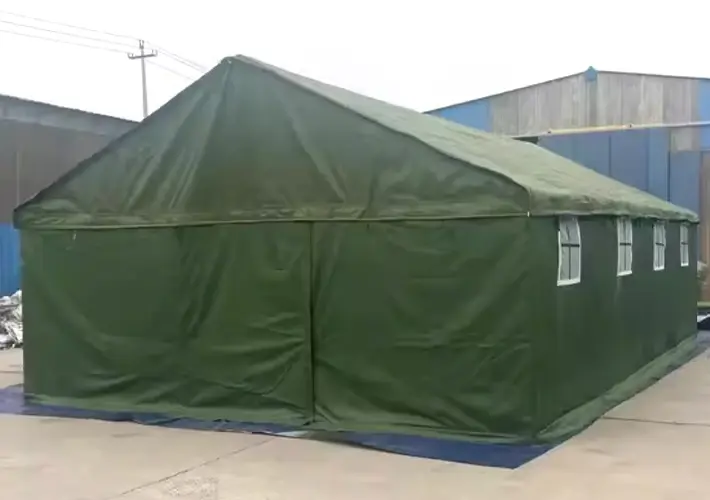
Environmental and Sustainability Considerations
Modern manufacturing is shifting towards eco-friendly materials. Many factories now produce:
- Recyclable PE tarps
- Low-VOC PVC coatings
- Biodegradable canvas tarps
For companies seeking to reduce carbon footprint or comply with green certification requirements (like LEED), choosing recyclable or non-toxic materials is a strategic advantage.
Conclusion: Choose Smart, Choose Long-Term Value
Choosing the right tent or tarpaulin for your project isn’t just about the lowest price—it’s about durability, performance, and safety.
Here’s a quick summary of best practices:
- For short-term projects: PE tarpaulin is lightweight and affordable.
- For industrial or permanent structures: PVC-coated tarpaulin offers unmatched strength and weather resistance.
- For events or exhibitions: Choose fire-retardant, aesthetic PVC tents with customization.
- For agriculture: Opt for UV-stabilized PE tarps for cost-effective protection.
When selecting a supplier, prioritize certified factories, customization capability, and after-sales service. As one of China’s leading tarpaulin and tent manufacturers, our factory provides high-quality PE and PVC products, OEM support, and export services to over 60 countries worldwide.
If you’re looking for a trusted manufacturer of tents and tarpaulins for global projects, feel free to contact our team for specifications, free samples, and professional consultation.
Your project deserves reliable protection—choose quality that lasts.


